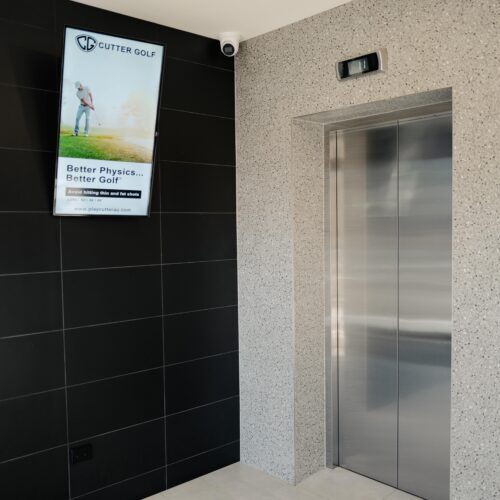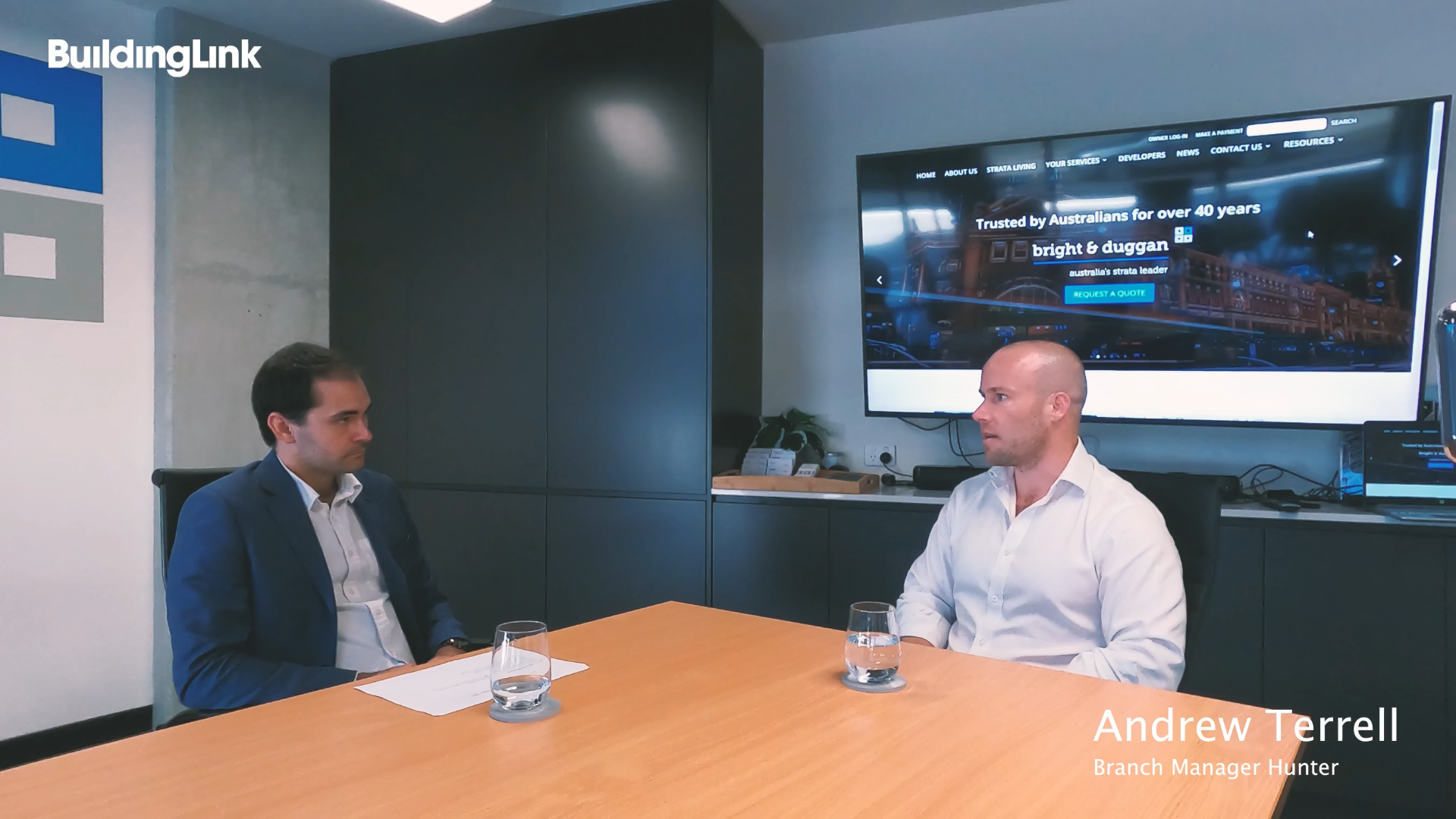Andrew Terrell, the Newcastle branch manager for Bright & Duggan joins us to share how BuildingLink have transformed the management of their Newcastle Strata Management office.
The business has grown exponentially over the past five years and now encompasses 12 different buildings with facilities management and around 2,000 units. The strata management in Newcastle continues to grow as buildings have literally grown up around the city over the past decade.
Andrew, can you tell us a little about how you’ve been using BuildingLink over the past years and the kind of feedback you get from your managers and residents about it?
“Sure, I’ve been acquainted with strata management software for years and years. When I took this position with Bright & Duggan 3 years ago, we looked at the software available and decided to go with BuildingLink. It’s proved to be a valuable decision because it’s been seamless – particularly for the buildings that don’t have onsite management.
With brand new buildings that have potential defects, owners and occupants need quick responses or want self-service, so provided you have entered all the information correctly, everything is available for people to get and maintenance has a place. It makes management much easier than dealing with everything via emails and calls.

And can you let us know how the transition between developer and strata management has been with BuildingLink?
“There are a number of builder-developers that we work with and also straight-developers that we work with. From the straight-developer perspective, they like it as they have complete transparency over how things are managed.
Builders love it for the same reason that we do – because everything is in one place and it’s a direct link to everything that’s needed. There are no spreadsheets being compiled based on phone calls and emails, everything is there, including contact details and you can do a little bit of analysis on where defects are coming from too. So yeah, our big developers that we work with up here all like utilizing it, and the building-developers are all over it.
That’s one of the reasons why it’s so good, it’s so easy for people to get up and running, there is a distinct purpose and it’s dead simple.
How do you find BuildingLink works with the remote management model you run for some of your communities?
“We think that it’s the future. We’ve come from a place where there are divergent views on how buildings should be managed. Quite often the caretaker management type of model that’s common in Queensland doesn’t make sense here.
Quite often there’s a professional real estate agent and a property manager who’s already doing property management. What we’re seeing now is that a lot of the buildings require an element of building management rather than just a strata manager. They need professional input for the complex machinery – lifts, hydraulics and large-scale mechanical stuff – so they need a building manager to come along every now and then rather than all the time.
It’s more cost-effective to do that, because strata managers are administrators and although we have a lot of core knowledge of R & M and preventative maintenance, it’s not our sweet spot, so that’s where facilities management comes in. That’s the model that the Bright & Duggan and Cambridge partnership is working with on a number of buildings that are run on a part-time basis effectively.
BuildingLink fits into that by providing a platform to hold all of the necessary information – so residents’ contact details and it allows us to communicate well with people. Then the second element of BuildingLink, is when people start interacting with the system to book lifts and that type of thing. It makes management easier.
Then of course you have the display screens that can be used to notify occupants about notices or contractors who are coming into the building about key information.

How do the digital displays from Premium Living Media (PLM) work with your buildings and BuildingLink?
“We’ve had screens in buildings for many years and being able to put up dynamic information works better and makes more sense than someone printing notices and physically putting them up in buildings.
From day dot, we’ve been pushing for screens in buildings with internet connections and we’ve now got 15 plus buildings with those screens. We’re putting them in all of our new buildings and PLM is working well with us on that.
The screens give us a variety of information to display for the buildings and also the advertising revenue subsidises cost a little bit too.
These screens are on top of the communication functions of BuildingLink too – the SMSs, emails, etc. so they work well together.
How do you find PLM for pushing out content and advertising but also critical information in real-time. Have you had any feedback from the residents?
“We probably don’t yet use this to its fullest ability, but I notice that when I’m in a building with these screens I can easily see if scheduled maintenance is coming up – I should probably already know this, but there are a million things I need to know each day. So that’s very informative and it’s fantastic for giving people an understanding of what’s going on in their building.
The more information points that are available allow people to passively receive information.

Do you find that the number of people knocking on the door of the building or strata manager asking for that kind of information is reduced when these screens are being used?
“Yes. The more you can communicate in an outbound manner, the less communication you’re going to get inbound. If you’ve received a call about something once, you can figure you’re going to hear from someone else about the same thing. So the best thing you can do is send out a communication straight away as a building manager and get that out by whatever means possible – SMS, email, screens.
Especially for water outages, lift outages, the high-impact things that people want to know about because you may as well give [residents] the information as soon as you’ve got it. Proactive communication is better.
What’s the intended strategy for PLM screens in Bright & Duggan buildings?
We had seen display screens in commercial buildings for some time and had always wondered when this would come through for residential buildings. Now that it’s here, we can see that there is probably space for two screens in buildings, one for notices and one for a ‘what’s happening today’ board with friendly stuff and maintenance details as well.
We believe that this is the future for residential buildings.
Putting your advertising hat on for a moment, do you think these screens present an opportunity for local businesses – coffee shops, restaurants and the like – to advertise to a captive audience and work their way out of the crunch from COVID-19?
Absolutely, 100%, it’s one of the best ways to get your name out there in terms of a local business to offer something suited to that audience. Just as the COVID has changed behaviour around travel and whatnot, more people are supporting local and shopping local where possible.
When you have a specific offering that has 150, 200 eyeballs seeing it a couple of times each day and could pique people’s interest, why not try something new? It’s perfect for cafes, gyms, liquor stores and small supermarkets and we have a lot of those kinds of businesses like that in Newcastle. If there is a valuable offering that’s tailored to residents, some of them are going to take it up.
Thanks for taking the time to chat with us today Andrew about your role and how BuildingLink fits with Bright & Duggan and Cambridge’s communities. It’s been a pleasure having some insights into how we support your work.
